



















|
 |
|
 |

The Saka-Rauka are one among several nomadic groups in Central Asia. In the beginning they fight with basically two troop types: horse archers & armored cavalry, with a few variations. Should the Saka expand southwards and conquer Baktria & India they will be able to recruit other troop types, notably heavy infantry & elephants.
Payai Dunai (Saka Foot Archers)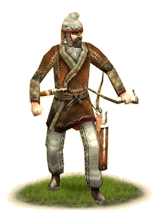 These Saka Foot Archers are foot bowmen. They are dismounted tribesmen who choose to fight on foot, utilizing the advantage of shooting more accurately and releasing longer, more powerful volleys as a result of standing upon a relatively more stable and level platform than on the back of a horse. The bows they carry are a fairly large recurved composite bow, one that, with its relatively longer siyahs and body show a deviation from the traditional Skythian recurved composite bow and a transition to the later "Sassanian" and "Hun" types of more eastern steppe nomads, enabling them to outrange, outshoot, and outpower steppe nomad horse archers. These foot bowmen are the ideal counter to horse archers in a stationary exchange of missiles with the latter. However, given their advantages in returning fire from the ground, they are also extremely vulnerable to heavy infantry and cavalry charges since these foot bowmen are still suited to more of a harassing and supporting role due them being merely armed with a short sword, the akinakes of Scythian origin, and no other melee weapon. These Saka Foot Archers are foot bowmen. They are dismounted tribesmen who choose to fight on foot, utilizing the advantage of shooting more accurately and releasing longer, more powerful volleys as a result of standing upon a relatively more stable and level platform than on the back of a horse. The bows they carry are a fairly large recurved composite bow, one that, with its relatively longer siyahs and body show a deviation from the traditional Skythian recurved composite bow and a transition to the later "Sassanian" and "Hun" types of more eastern steppe nomads, enabling them to outrange, outshoot, and outpower steppe nomad horse archers. These foot bowmen are the ideal counter to horse archers in a stationary exchange of missiles with the latter. However, given their advantages in returning fire from the ground, they are also extremely vulnerable to heavy infantry and cavalry charges since these foot bowmen are still suited to more of a harassing and supporting role due them being merely armed with a short sword, the akinakes of Scythian origin, and no other melee weapon.
Historically, steppe nomads at times employed infantry in their ranks, even though they usually fought as cavalry. They would mount these men on camels or horses so as to keep pace with the majority of the army, which was the cavalry, and when they did battle, they would dismount from their horses and release volleys of arrows with deadly accuracy and power against their foes. In his "Geography", Strabo said that among the ranks of the Massagetae, another Indo-Iranian steppe people who were probably kinsmen of the Saka, were those who lived in the mountains, plains, marshes, and islands, and that, in addition to having excellent cavalry, they also had good foot soldiers as well.
Halstehveyyau (Saka Spearmen)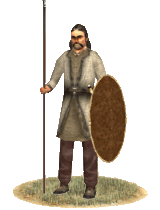 These Saka spearmen wear no armour and carry a shield and spear to battle. They are medium, passable infantry and can hold their own against other medium-low quality infantry of a similar nature. However, due to their lack of armour, they are best not employed against the heavier infantry of settled peoples. As such, they should not be expected to engage the bulk of the enemy forces in battle. Probably their best asset is their ability to defend ground or support heavier troops when assaulting a settlement. These Saka spearmen wear no armour and carry a shield and spear to battle. They are medium, passable infantry and can hold their own against other medium-low quality infantry of a similar nature. However, due to their lack of armour, they are best not employed against the heavier infantry of settled peoples. As such, they should not be expected to engage the bulk of the enemy forces in battle. Probably their best asset is their ability to defend ground or support heavier troops when assaulting a settlement.
Historically, after groups of Saka Rauka left the steppes and invaded the Graeco-Baktrian kingdom and Gandhara/Kapisa and established settled Indo-Saka kingdoms in northern India, they seemed to have maintained a considerable amount of the preceding Greek and native infrastructures, possibly due to the want of stable administration of the newly established empire. It can be supposed that, while the original cavalry-oriented element of their ancestors had been maintained, the Indo-Saka also employed native and Greek troops who were mainly infantry-oriented, and thus a general increase in the amount of infantry in their armed forces. Probably many Indo-Saka, being settled down, took to infantry-oriented fighting during this time due to the general decrease in the supply of horses since they had lost control of the Central Asian steppes long ago; on a pillar relief from the palace area at Nagarjunikonda is displayed a foot guard holding a spear dressed in Indo-Saka costume and although dated to a later period, he may well be representative of those settled Indo-Saka who took to infantry-oriented fighting. However, among other Saka groups, such as those of the Massagetai, passable and competent infantry forces seemed to have existed regardless of tribesmen taking to farming and a settled lifestyle; in Herodotos' short "inquiry" of the Massagetai, it is stated that the Massagetai relied on both cavalry and infantry to fight battles, neither methods being foreign to them, and that some tribesmen in the Massagetai were also hunter-gatherers as well as transhumant pastoralists.
Duna Asya (Saka Horse-Archers)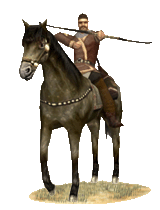 These are tough Saka from the north-eastern frontiers of the Parthian Empire and the lands beyond. Living a tough life, they learn to ride as soon as they can walk, and they are masterful horsemen. The Saka nomad's primary weapon is the composite bow, the new asymmetrical so called 'Hunnish' bow rather than the Scythian composite bow. The steppe pony they ride is a hardy beast, though small and shaggy. Considered unattractive by more settled folk, it is well able to survive in the harsh steppe climate and can thrive on grass alone, not requiring the daily grain feed of more finely bred mounts. This allows their nomadic riders to range far and wide, not hampered as more traditional cavalry would be. These are tough Saka from the north-eastern frontiers of the Parthian Empire and the lands beyond. Living a tough life, they learn to ride as soon as they can walk, and they are masterful horsemen. The Saka nomad's primary weapon is the composite bow, the new asymmetrical so called 'Hunnish' bow rather than the Scythian composite bow. The steppe pony they ride is a hardy beast, though small and shaggy. Considered unattractive by more settled folk, it is well able to survive in the harsh steppe climate and can thrive on grass alone, not requiring the daily grain feed of more finely bred mounts. This allows their nomadic riders to range far and wide, not hampered as more traditional cavalry would be.
Historically, Saka cavalry fought both within and against Parthian armies. Shooting accurately with a bow while on horse-back took long training and, thus, many “Parthian” mounted bowmen were levied from the vassal tribes on the Empire’s border marches, who were renowned for their horsemanship and fighting skill. Most Saka horsemen in Parthian service were part of contingents supplied by tribal allies/subjects, but some might have been mercenaries. Occasionally, they appear to have formed their own units and fought under their own chieftains. In any case, they have their own sense of loyalty and cannot be relied on to fill important roles. They could be used, though, to bulk up the line of horse archers in a Parthian, providing the Parthian Kings with another vital source of light cavalry. When fighting for themselves, the Saka proved a force to be reckoned with. Hostile Saka managed to slay two Parthian kings in battle and when the Parthians finally drove them out, they coalesced with related groups of nomads from further east to overran Northern India, forming the Indo-Saka kingdoms there.
Assa-Barai (Saka Riders)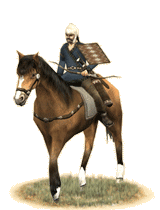 These Saka Riders carry a larger version of the "Skythian" recurved composite bow, one in a transitional stage, as their primary weapon and a spear as a secondary weapon. In addition, they are armed with leather armour and wickerwork shields, being slightly better armed than the majority of the tribesmen; still, these riders are light cavalry and, as such, are best employed as the majority of tribesmen are - that of harassing the enemy at long range with their powerful recurved composite bows, with the effect of demoralizing as well as decimating a considerable amount of enemy soldiers. Due to their extra defenses, they can be expected to hold their own against the lightly-armoured cavalrymen of settled peoples and will rout any light missile infantry that are foolish enough to engage them in melee combat. These Saka Riders carry a larger version of the "Skythian" recurved composite bow, one in a transitional stage, as their primary weapon and a spear as a secondary weapon. In addition, they are armed with leather armour and wickerwork shields, being slightly better armed than the majority of the tribesmen; still, these riders are light cavalry and, as such, are best employed as the majority of tribesmen are - that of harassing the enemy at long range with their powerful recurved composite bows, with the effect of demoralizing as well as decimating a considerable amount of enemy soldiers. Due to their extra defenses, they can be expected to hold their own against the lightly-armoured cavalrymen of settled peoples and will rout any light missile infantry that are foolish enough to engage them in melee combat.
Historically, horse archers with little to no armour formed the majority of pastoral nomad confederacies such as those of the Saka Rauka, and their mobility due to their light armour had always been their greatest asset in confrontation against slower armies, like the largely infantry armies of settled peoples. Methods of attack employed by these highly mobile light cavalrymen usually revolved showering the enemy with arrows at long-range with a demoralizing effect on the enemy or drawing certain contingents of the enemy into ambushes by feigned retreats and the such; when victory in a field battle could not be achieved, by virtue of their mobility, the nomads would go behind enemy lines and continually harass and attack their supply lines until the enemy yielded. With such armies, the Saka nomads were able to relentlessly devastate the bordering lands of the settled peoples, such as the frontier region of the trans-Jaxartes during the Achaimenid, Alexandrian, Seleukid, and Graeco-Baktrian periods. Arrian states that when Alexander was fighting outlaws of the Saka Haomavarga at the trans-Jaxartes frontier, a missile from a catapult struck a Saka warrior armed with a corselet and a shield; such a warrior probably belonged to a tribal clan slightly wealthier than most others but probably still functioned like a lightly-armoured cavalryman. Additionally, wooden shields have been found at the Pazyryk burials in the Altai. Probably such warriors existed among the Saka Rauka as well.
Asya Badarai (Saka Heavy Cavalry)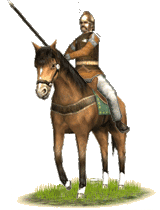 Wielding a two-handed kontos and riding fast and strong horses, the Saka Lancers are capable of mounting a powerful charge. Their second weapon is a sagaris battleaxe, effective against armor, so they can inflict substantial damage even to well-protected enemies in close hand-to-hand combat. However, they do not wear much armor themselves, only a helmet and a leather jacket or corselet, and, consequently, they are likely to suffer casualties in forced to engage in a protracted melee. They will also be somewhat vulnerable to archery. The charge is certainly the strongest point of Saka Lancers and a wise commander will seek to use them in a way that maximizes the benefits from this ability. Charging and a quick retreat, only to charge back again, and a judicious selection of the target in terms of both moment and location should probably be their standard mode of operation in the battlefield. Wielding a two-handed kontos and riding fast and strong horses, the Saka Lancers are capable of mounting a powerful charge. Their second weapon is a sagaris battleaxe, effective against armor, so they can inflict substantial damage even to well-protected enemies in close hand-to-hand combat. However, they do not wear much armor themselves, only a helmet and a leather jacket or corselet, and, consequently, they are likely to suffer casualties in forced to engage in a protracted melee. They will also be somewhat vulnerable to archery. The charge is certainly the strongest point of Saka Lancers and a wise commander will seek to use them in a way that maximizes the benefits from this ability. Charging and a quick retreat, only to charge back again, and a judicious selection of the target in terms of both moment and location should probably be their standard mode of operation in the battlefield.
Historically, the Makedonian invasion of the Achaemenid Empire brought the nomads of the Central Asian steppes, peoples with a long tradition of cavalry warfare of their own, into contact with horsemen charging into contact with the enemy using long lances as done by the Makedonian Hetairoi. The nomads were quick to incorporate this innovation into their own practices, and the partnership of mounted lancers and horse archers would define warfare in the Eurasian steppes for centuries to come. Along history, mounted lancers often wore substantial amounts of armor, at times extended to their horses, as seems fitting for troops destined to engage their enemies at close quarters. However, we also have evidence contemporary with the nomad-Makedonian contact or shortly after it (a terracotta from Koi-Krylgan-Kala, modern Uzbekistan, for example) for unarmored riders atop unprotected horses, wielding long, two-handed lances.
Ysaninu Aysna (Early Saka Nobles)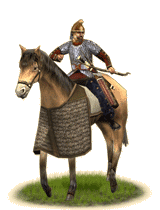 Protected with helmets and good quality scale armor, riding horses with frontal barding and wielding stout spears, these Saka Nobles can give a good account of themselves in hand to hand combat. Also, they are no less adept with the strong, composite bows they carry than poorer, more lightly-equipped horse archers and only slightly less agile. This combination makes them suitable for a variety of tasks. These are warriors that can attack infantry under the right conditions, that can go toe to toe with most other cavalry (or evade and shoot horsemen they would rather not face in melee) and that will win archery duels with the elusive horse archers (or will chase them off the battlefield). Cavalry armed with the long, two-handed lances may prove their better in melee, and, of course, frontal charges against decent infantry in good order will likely be suicidal. Against such foes, cooperation with the lighter horse archers that should abound in any Saka army and the Nobles’ own bows should prove very useful. All in all, the Early Saka Nobles are a valuable unit of great flexibility. Of course, the price of their expensive war gear will often mean than not many of them will be present in most Sakae armies. Protected with helmets and good quality scale armor, riding horses with frontal barding and wielding stout spears, these Saka Nobles can give a good account of themselves in hand to hand combat. Also, they are no less adept with the strong, composite bows they carry than poorer, more lightly-equipped horse archers and only slightly less agile. This combination makes them suitable for a variety of tasks. These are warriors that can attack infantry under the right conditions, that can go toe to toe with most other cavalry (or evade and shoot horsemen they would rather not face in melee) and that will win archery duels with the elusive horse archers (or will chase them off the battlefield). Cavalry armed with the long, two-handed lances may prove their better in melee, and, of course, frontal charges against decent infantry in good order will likely be suicidal. Against such foes, cooperation with the lighter horse archers that should abound in any Saka army and the Nobles’ own bows should prove very useful. All in all, the Early Saka Nobles are a valuable unit of great flexibility. Of course, the price of their expensive war gear will often mean than not many of them will be present in most Sakae armies.
Historically, the steppe nomads of western Central Asia had a tradition of armoured cavalry troops that fought besides lighter horse archers. Herodotos mentions that the Massagetae used war-horses with bronze breastplates. Arrian notes that the “Scythians” (here a very general term for Iranian-speaking nomads that includes the Sakae) that came as Persian allies for the battle at Gaugamela wore more protection for rider and horse than the Macedonian Hetairoi they fought. Speaking of the same battle, Quintus Curtius reports that, Darius III carried out a reform of arms prior to it. Among other things, the reform included the introduction of protective, metal armour for both rider and horse. Quite likely, this actually reflects the recruitment of Saka cavalry to face the Macedonian heavy cavalry in the decisive battle. Archaelogical finds (a representation on a terracotta from Khumbuz-Tepe, in the lower Amu-Darya valley, late IV or early III BC) confirm these written sources.
Ysaninu Aysiramjä (Saka Cataphracts)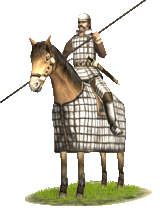 These fearsome warriors wear an armoured jacket fitted at the waist and made of large metal plates. Their necks are protected by high armoured neck-guards, their arms by brassarts made of steel or hard leather bands and their legs by greaves. The casque they wear, originally made of cast bronze, was riveted or welded by several iron pieces. Their horses are protected by an armoured cloth. They carry a long kontos lance for the shock action during the first charge and a deadly sagaris battle-axe that can cut through the heaviest of armour in melee combat. These heavily armoured warriors are the most powerful shock arm available to the Saka and represent the epitome of Saka military achievements in the history of heavy cavalry. Their weapon set was the prototype from which the famous Pahlava kataphraktoi used in later history and they are kataphraktoi in their own right. In cooperation with light horse archers and other less heavily armoured units using primarily the larger recurved composite bow for offense as was the case in Central Asian nomadic warfare, they are best used after their lighter companions have weakened and "softened" up the enemy. Yet, they are still a valuable asset even when used alone, for no enemy except the most disciplined and armoured of infantry units can withstand their fearsome charges and nasty blows they deliver to their foes during melee combat. These fearsome warriors wear an armoured jacket fitted at the waist and made of large metal plates. Their necks are protected by high armoured neck-guards, their arms by brassarts made of steel or hard leather bands and their legs by greaves. The casque they wear, originally made of cast bronze, was riveted or welded by several iron pieces. Their horses are protected by an armoured cloth. They carry a long kontos lance for the shock action during the first charge and a deadly sagaris battle-axe that can cut through the heaviest of armour in melee combat. These heavily armoured warriors are the most powerful shock arm available to the Saka and represent the epitome of Saka military achievements in the history of heavy cavalry. Their weapon set was the prototype from which the famous Pahlava kataphraktoi used in later history and they are kataphraktoi in their own right. In cooperation with light horse archers and other less heavily armoured units using primarily the larger recurved composite bow for offense as was the case in Central Asian nomadic warfare, they are best used after their lighter companions have weakened and "softened" up the enemy. Yet, they are still a valuable asset even when used alone, for no enemy except the most disciplined and armoured of infantry units can withstand their fearsome charges and nasty blows they deliver to their foes during melee combat.
Historically, these warriors were composed of accomplished nobles or other elites of Saka society, for the costly defensive weapon set that they wore was not attainable by regular tribesmen. While the style of shock cavalry warfare and some of the kataphraktoi's equipment was already centuries old and possibly has its roots to those of the Massagetai, Iranian kinsmen and neighbours of the Saka, this weapon set of the kataphraktoi that was first developed among the Saka can only be traced to the time right before Alexander's invasion of the Achaemenid empire. Combining local autochthonous developments along with the military developments of both the Achaemenids and the Warring States of China, the former due to their fight against Achaemenid rule in the west, and the latter due to their active participation in the turmoil on the northwestern frontier of the Warring States, the Saka developed a set of arms in the late 4th - 3rd centuries BC that became prevalent amongst the heavy cavalry such that this army component turned into a decisive factor on the battlefield. According to one authority, influence from the Warring States can especially be seen, as he notes that the Saka method of securing their sword belt and accoutrements were borrowed from the Chinese Warring States; he further notes that even the pommels, the guards, the loops or scabbard slides, the scabbard tips which were often made of jade, were all directly imported from China. He also indicates that these weapons had been used by both the Skythians and Persians, and by Chinese chariot fighters and infantryman, the latter two probably referring to the Qin chariot fighter from Qin Shihuang Di's famous mausoleum (3rd century BC) near Xian and also to the suits of armour made of large lacquered leather plates with the high neck-guard found from a tomb at Suixian, Hubei, just north of the ancient kingdom of Chu, dated to the 5th century BC. There also exists in what may be the earliest archaeological depiction of a fully armoured kataphraktoi on a fragmentary terracotta flask piece from Khumbuz-tepe in southern Chorasmia/Khorezmia, dated to the 4th-early 3rd centuries BC, which, although attributed to the Massagetai or the Dahai due to geographical rendition, can also represent kataphraktoi development among the Saka. There are also historical references to heavily armoured Saka warriors in the written sources as well. For example, from Arrian's Anabasis, Book 3, Chapter 8, we learn that a Saka cavalry contingent under a certain Saka chief Mavakes aided the Achaemenids at Gaugamela in 331 BC; he also further informs us that these "Skythians", aided by Baktrian cavalry routed the Greek cavalry mercenaries that Alexander initially sent against them. Immediately, they fought a fierce battle against the combined Makedonian, Greek, and Paeonian cavalry of Alexander and inflicted huge casualties on Alexander's right wing, almost putting them to rout, for Arrian further says that the Saka cavalrymen also had much more armour protecting their horses than did Alexander's cavalry. Additionally, we are told by Arrian in Book 4, Chapter 4, that a Saka warrior was struck through his wicker shield and corselet by missiles hurled from Alexander's military engines that he had loaded when attempting to cross the Tanais (Jaxartes - modern Syr-Darya river).
Spatahaura Hadabara (Saka Armored Nobles)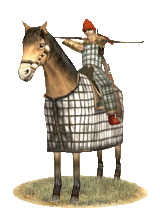 These riders are the inheritors of a style of cavalry warfare which is already centuries old in Central Asia. Among the many variations on the theme of an armoured horsemen with variable amounts of protection for his mount as well, they represent one that has preserved in their gear features already present in the first known examples. Thus, their armour is made of relatively large square plaques, rather than smaller scales or lamellae and the protection for the rider’s legs takes the shape of wide armoured chaps that, thanks to their size, also defend the horse’s flanks. Those designs may be ancient, but their very survival attests to their efficiency. In contrast, their offensive equipment is quite more recent. They already carry composite bows of the larger, more powerful type that has recently appeared in the eastern steppes and that will eventually replace the “Scythian” model. To that, they add long, stout kontos lances that allow them to mount a fearful charge after they have weakened their foes with archery; both its own and from the numerous horse archers that typically should operate alongside them. These riders are the inheritors of a style of cavalry warfare which is already centuries old in Central Asia. Among the many variations on the theme of an armoured horsemen with variable amounts of protection for his mount as well, they represent one that has preserved in their gear features already present in the first known examples. Thus, their armour is made of relatively large square plaques, rather than smaller scales or lamellae and the protection for the rider’s legs takes the shape of wide armoured chaps that, thanks to their size, also defend the horse’s flanks. Those designs may be ancient, but their very survival attests to their efficiency. In contrast, their offensive equipment is quite more recent. They already carry composite bows of the larger, more powerful type that has recently appeared in the eastern steppes and that will eventually replace the “Scythian” model. To that, they add long, stout kontos lances that allow them to mount a fearful charge after they have weakened their foes with archery; both its own and from the numerous horse archers that typically should operate alongside them.
Historically, Sakae cataphracts seem to have transmitted the concept of armoured cavalry to other groups of nomads that lived further east. For example, the Yuezhi apparently had no Cataphract-like cavalry until they contacted the Sakae in their westward migration. Then, they eagerly took up the idea from either the Sakae groups they displaced or those others they seem to have incorporated into their polity and their armies. That Sakae armoured riders were a prestigious arm, is clear as we see the rulers of the kingdoms the Sakae would found in Northern India and Pakistan routinely chose to be depicted in that guise in their coins.
Daha Baexdzhyntae (Dahae Riders)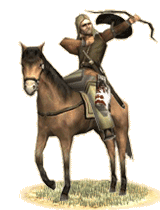 Dahae Riders carry a long spear and a shield besides their bows and are willing to press home a charge if circumstances are right. Even more significantly, they maintain a very useful tactical flexibility as they can skirmish and put their bows to very good use against solidly formed enemies that would repulse a headlong charge. As such, they are some of the finest light horsemen available to the Arsacid Kings of Parthia, the Hellenistic monarchs of Baktria, powerful nomadic rulers or anyone who manages to have them as either mercenaries, allies or nominal subjects. Dahae Riders carry a long spear and a shield besides their bows and are willing to press home a charge if circumstances are right. Even more significantly, they maintain a very useful tactical flexibility as they can skirmish and put their bows to very good use against solidly formed enemies that would repulse a headlong charge. As such, they are some of the finest light horsemen available to the Arsacid Kings of Parthia, the Hellenistic monarchs of Baktria, powerful nomadic rulers or anyone who manages to have them as either mercenaries, allies or nominal subjects.
Historically, the Daha, which is the Persian word for "robbers", were a tribe who held the lands to the northeast of Persia. The Parthians themselves were a branch of this people. In common usage the term was used to denote any of the nomadic raiders who made life difficult for the settled peoples of Persia. These raiders would descend on Persian settlements and villages to pillage and burn when the opportunity presented itself. They would be mounted on the steppe pony, renowned for it's courage and endurance. These animals only needed to be watered once a day, and they could dig for grass under the snow, which eliminated the army's need to carry feed. These are strong animals, twelve or thirteen hands high, with powerful chests and necks, large hook-nosed heads and well-built legs; they had a very fast gait. they were hardy and invaluable for long distances. astride small shaggy ponies Many of these horses could carry their masters a hundred miles between dawn and sunset and the same horse would pass the night unsheltered, in pouring rain and sub-zero temperatures, without taking harm from these harsh conditions. As such they are some of the finest light horsemen available to the Arcsacid Kings of Parthia.
Daha Rog Baexdzhyn Aefsad (Dahae Skirmisher Cavalry)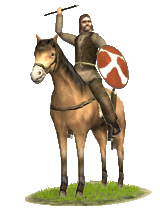 These Dahae skirmisher cavalry are best used in a harassing role and can be very useful in tempting enemy heavy cavalry to mount a charge in a vain attempt to catch them. They carry an abundant supply of javelins in saddle-cases. The traditional role of mounted archers is well known, but the heavier javelin is more dangerous to armoured opponents. These wild tribesmen fill a vital role in the clan host. While they do make excellent skirmishers, this is not their only calling. They are warriors of the steppe and wield spears with skill and courage, willing to close with the enemy when the odds are in their favour. These Dahae skirmisher cavalry are best used in a harassing role and can be very useful in tempting enemy heavy cavalry to mount a charge in a vain attempt to catch them. They carry an abundant supply of javelins in saddle-cases. The traditional role of mounted archers is well known, but the heavier javelin is more dangerous to armoured opponents. These wild tribesmen fill a vital role in the clan host. While they do make excellent skirmishers, this is not their only calling. They are warriors of the steppe and wield spears with skill and courage, willing to close with the enemy when the odds are in their favour.
Historically, the Daha tribes of eastern Iran are part of the vast conglomerate of Iranian-speaking steppe nomads and members of the great tribal amalgam that spawned the Parni tribe, better known to history as Parthians. By 270 BC the Dahae had spread into northern Margiana, Sogdiana and south of the Aral Sea. While they fielded many horse archers, the javelin was commonly used as well because it had greater piercing power and heavier equipment was getting more and more common on the steppe.
Daha Uazdaettae (Dahae Noble Cavalry)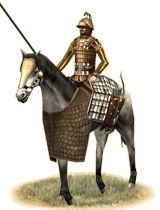 The Daha Uazdaettae are the elite of the Dahae tribal confederacy and are usually seen leading the tribal host to war. They are not above service to more settled peoples as this will often grant them the means to better equip themselves for war. These noblemen can harass an enemy line like skirmishers and charge into unprotected flanks and rears when the opportunity presents itself. They are equipped with a hardened leather scale cuirass or the occasional bronze or iron scale ciurass taken in raids. Daha Uazdaettae are equipped with composite bow and lance making them a versatile and dangerous foe. These men wield lance and bow with supreme skill and courage, closing with the enemy when the odds are in their favour. This gives them a tactical flexibility as they can skirmish and put the bows they carry to very good use against solidly formed enemies that would repulse a headlong charge. The Daha Uazdaettae are the elite of the Dahae tribal confederacy and are usually seen leading the tribal host to war. They are not above service to more settled peoples as this will often grant them the means to better equip themselves for war. These noblemen can harass an enemy line like skirmishers and charge into unprotected flanks and rears when the opportunity presents itself. They are equipped with a hardened leather scale cuirass or the occasional bronze or iron scale ciurass taken in raids. Daha Uazdaettae are equipped with composite bow and lance making them a versatile and dangerous foe. These men wield lance and bow with supreme skill and courage, closing with the enemy when the odds are in their favour. This gives them a tactical flexibility as they can skirmish and put the bows they carry to very good use against solidly formed enemies that would repulse a headlong charge.
Historically, the Dahae tribes of eastern Iran are part of the vast conglomerate of Iranian-speaking steppe nomads and members of the great tribal amalgam that spawned the Parni tribe, better known to history as Parthians. The Dahae (Old Persian Daha = "robbers") were a tribe who held the lands to the northeast of Persia. Nomadic warfare among these peoples remains firmly based on horse archery and skirmishing.
Yancai Uaezdaettae (Alan Nobles)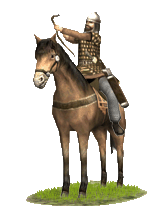 Yancai Nobles represent one of the many variations of Central Asian cavalry that combine a long, two-handed lance and a composite bow. This offensive gear can be accompanied by very variable amounts of protection for both horse and rider, from no armour at all for either to full metal scale corselets and bardings. Yancai Nobles are relatively closer to the “light” end along this continuum, with unprotected horses and the riders wearing padded leather jackets with pieces of metal sewn over it. Consequently, they can suffer from missiles or protracted combat against heavier opponents. In exchange, what they wear gives good protection for a reasonable expense and, being relatively light, still allows these troops to rely on speed and agility. Their charges are furious and effective, but they should be repeated, rather than left them mired in melee. Yancai Nobles represent one of the many variations of Central Asian cavalry that combine a long, two-handed lance and a composite bow. This offensive gear can be accompanied by very variable amounts of protection for both horse and rider, from no armour at all for either to full metal scale corselets and bardings. Yancai Nobles are relatively closer to the “light” end along this continuum, with unprotected horses and the riders wearing padded leather jackets with pieces of metal sewn over it. Consequently, they can suffer from missiles or protracted combat against heavier opponents. In exchange, what they wear gives good protection for a reasonable expense and, being relatively light, still allows these troops to rely on speed and agility. Their charges are furious and effective, but they should be repeated, rather than left them mired in melee.
Historically, armoured cavalry had a long tradition in Central Asia warfare being present in peoples like Massagetae, Sakae, etc. since long. Apparently, sometime in the 4th century BCE, probably due to the contact with hard-charging Makedonian cavalry during Alexander’s campaigns, this cavalry evolved into a troop type that, in different forms, would remain an integral part of warfare for centuries to come: the mounted lancer. The Yancai, a group of Iranian nomads probably related, if not descended from the Massagetae and who at I AD became the better known Alans, were practitioners of this style of warfare and contributed to its spread westwards.
Indo-Saka units
These units are available after the Saka have undergone the Indo-Saka reforms.
Sahiya Hadabara (Saka Late Cataphract)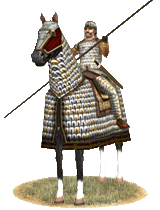 These men represent the champions of Indo-Saka society that have distinguished themselves as a feared force of crack cavalry. As a part of the Indo-Scythian sovereign’s equestrian bodyguard, they are expected to be of exceptional quality, both in martial ardour and horsemanship, a virtue valued especially by the Saka who never truly abandoned their nomadic roots even though they historically extended their rule to such degree as rivalling their Parthian nemesis to the west, and probably branding themselves as the most influential of dynasties in India. These men were armed and fought like cataphracts, and likely provided the basis and the rolemodel of the feared Kushan cataphracts.
Armed with the kontos, the Saka king had a retinue of horsemen able to mount a devastating charge. After the charge the cataphract could sustain himself in melee, fighting either with a Scythian-style longsword or a mace, able to inflict damage on unarmoured as well as armoured foes. Armoured with a lamellar cuirass and helmet along with laminated trousers and laminated arm defences, and with his charger armoured in a complete lamellar barding, this cataphract boasts with defences as formidable as the Parthian rival to the west. Later, the Indo-Saka would come to adopt more of the previous Hellenic, but also Indian features in smithcrafting. Adding a decorative facing was not uncommon if it could be afforded; The cataphract here is largely armoured in iron, but the arms are faced with copper. These men represent the champions of Indo-Saka society that have distinguished themselves as a feared force of crack cavalry. As a part of the Indo-Scythian sovereign’s equestrian bodyguard, they are expected to be of exceptional quality, both in martial ardour and horsemanship, a virtue valued especially by the Saka who never truly abandoned their nomadic roots even though they historically extended their rule to such degree as rivalling their Parthian nemesis to the west, and probably branding themselves as the most influential of dynasties in India. These men were armed and fought like cataphracts, and likely provided the basis and the rolemodel of the feared Kushan cataphracts.
Armed with the kontos, the Saka king had a retinue of horsemen able to mount a devastating charge. After the charge the cataphract could sustain himself in melee, fighting either with a Scythian-style longsword or a mace, able to inflict damage on unarmoured as well as armoured foes. Armoured with a lamellar cuirass and helmet along with laminated trousers and laminated arm defences, and with his charger armoured in a complete lamellar barding, this cataphract boasts with defences as formidable as the Parthian rival to the west. Later, the Indo-Saka would come to adopt more of the previous Hellenic, but also Indian features in smithcrafting. Adding a decorative facing was not uncommon if it could be afforded; The cataphract here is largely armoured in iron, but the arms are faced with copper.
Historically, the Saka equestrian traditions revolved around horse archery, feigned retreat and combat on horseback. When the Saka became the Indo-Saka, they had not only learned a few tricks from their Parthian neighbour concerning the role of heavy cavalry, they had essentially settled in north-western India, adopting a melange of Iranian, Greek and Indian traditions of warfare. The strong roots in Saka equestrian traditions would culminate into the rolemodel of the later Kushan cataphracts of the 2nd century CE.
Hoplitai Indohellenikoi (Indo-Hellenic Medium Infantry)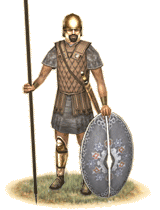 Hoplitai Indoi are the lightest component of the regular Indo-Greek phalanx line, equipped with fairly light linothrax and ptyrges, and an equally light helm, though a heavy thuroes and bronze greaves afford them substantially greater defensive coverage then the traditional hoplitai of distant Hellas. They are arrayed in a traditional, non-Makedonian phalanx to prevent a need for more regular drilling and equipped with a thuroes to compensate for the lesser defensive value inherint in this lighter formation. In Baktrian and Saka armies, they are best used to support the more expert and elite linesman around them, the Pezhetairoi Indoi and Hoplitai Indoi Beltistoi in the case of the burgeoning Baktrian empire and the Hoplitai Hellenikoi and Agema Hellenikon in the case of the Philhellenic Saka Kingdom. Hoplitai Indoi are the lightest component of the regular Indo-Greek phalanx line, equipped with fairly light linothrax and ptyrges, and an equally light helm, though a heavy thuroes and bronze greaves afford them substantially greater defensive coverage then the traditional hoplitai of distant Hellas. They are arrayed in a traditional, non-Makedonian phalanx to prevent a need for more regular drilling and equipped with a thuroes to compensate for the lesser defensive value inherint in this lighter formation. In Baktrian and Saka armies, they are best used to support the more expert and elite linesman around them, the Pezhetairoi Indoi and Hoplitai Indoi Beltistoi in the case of the burgeoning Baktrian empire and the Hoplitai Hellenikoi and Agema Hellenikon in the case of the Philhellenic Saka Kingdom.
Historically, when the Baktrian Kingdom began its fairly rapid conquest of Northern India, they transplanted a large number of Iranians - Bahlikas and Kambojas in the native tongues - with them, serving variously as lower-order administrators or yoemen in their armies, immigrants, or in their massive auxilliary corps. These men, now settled in India and affected by both the native and conquorer's culture, along with partially Hellenized local Indians and the part-Indian children of Hellenic families, formed the bulk of this varied local levy. After the conversion of the Baktrian King Menander to Buddhism, as reported in various later Buddhist texts, they likely evolved into the bulk of his successors' light linemen - particularly his own locally supported dynasty, as represented by his son Strato and both their various namesakes. Other dynasties, like that of Zoilos centered in Arachosia or that of Antialkidas at Taxila also utilized such forces, though the former's ranks probably held more soldiers of Iranian extraction and the latter of loyal dharmayavanas (Hellenized Indiands). In the time of Hellenic rule, they had a fairly limited role and their position in Baktrian armies reflects this, but under the Saka, such men were a major component of their well-trained local regulars, second in the region only to the Agema Hellenikon.
Peltastai Indohellenikoi (Indo-Greek Peltasts)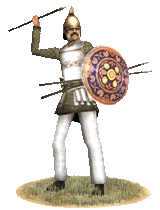 After the kingdom of Baktria attacked and seized its Indian possessions, it found the Greeks who had been living there had adapted somewhat to native ways. Gone was the close phalanx formation and the long spear, replaced by a somewhat looser but more skilled melee formation. They adopted a Phrygian style helmet, light cotton Thracian trousers, and javelins, in addition to a smaller and lighter shield. This allows them to be excellent elephant killers, as well as defeat the more lightly armored infantry of the east. They can be used as a good medium infantry, to screen the flanks and protect against elephants and cavalry while the Thureophoroi deliver the fatal melee blow. After the kingdom of Baktria attacked and seized its Indian possessions, it found the Greeks who had been living there had adapted somewhat to native ways. Gone was the close phalanx formation and the long spear, replaced by a somewhat looser but more skilled melee formation. They adopted a Phrygian style helmet, light cotton Thracian trousers, and javelins, in addition to a smaller and lighter shield. This allows them to be excellent elephant killers, as well as defeat the more lightly armored infantry of the east. They can be used as a good medium infantry, to screen the flanks and protect against elephants and cavalry while the Thureophoroi deliver the fatal melee blow.
Historically, the Indo-Greeks adapted quite well to the environment of India and prospered. Many became Buddhists, though they still remained fierce warriors, true to their Hellenic forbearers. They are an excellent medium infantry, well able to compliment other troop types and provide a versatile unit against light cavalry and elephants.
Hoplitai Hellenikon (Saka Heavy Hoplites)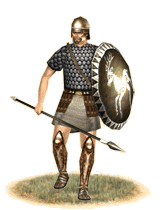 The Hoplitai Hellenikon are an extraordinarilly heavily armored evolution of the ancient Hoplitai of Hellas, combining the traditional Hellenic phalanx with the superb defense afforded by the prefered armor of the Steppes. They are among the most disciplined of infantry forces, lumbering forward under the initial cover of their extended spears, thick helmets, bronze greaves, and massive hoplons, while each man's torso is encased in a heavy suit of scale. Though this almost excessive armor compliment makes them among the least mobile of the Hellenic infantry variations, with a proper position, they are a nearly impenetrable force - and nearly as irresistible when engaged in melee. With the rapid advance of metallurgical techniques in the smithies of Hellenic workmen, the fusion of Hellenic order and discipline with Steppe scale-armor places these Hoplitai far ahead of other infantry with regards to armor; equipped to hold against both the heavily armored cavalry of the East and the eager, heavily armed infantry of the West. Under the right commander, used properly to compliment other units, they are a battle-winning force. The Hoplitai Hellenikon are an extraordinarilly heavily armored evolution of the ancient Hoplitai of Hellas, combining the traditional Hellenic phalanx with the superb defense afforded by the prefered armor of the Steppes. They are among the most disciplined of infantry forces, lumbering forward under the initial cover of their extended spears, thick helmets, bronze greaves, and massive hoplons, while each man's torso is encased in a heavy suit of scale. Though this almost excessive armor compliment makes them among the least mobile of the Hellenic infantry variations, with a proper position, they are a nearly impenetrable force - and nearly as irresistible when engaged in melee. With the rapid advance of metallurgical techniques in the smithies of Hellenic workmen, the fusion of Hellenic order and discipline with Steppe scale-armor places these Hoplitai far ahead of other infantry with regards to armor; equipped to hold against both the heavily armored cavalry of the East and the eager, heavily armed infantry of the West. Under the right commander, used properly to compliment other units, they are a battle-winning force.
Historically, when the Hellenic and the Steppe cultures and infrastructure met, adaptation ensued. The Hoplitai Hellenikon are one such adaptation; the natural result of the military traditions and designs of both. To the North of the Oxus, the Sakae hordes massed; clad in their superb armor, while to the South, the Hellenes prepared their ordered phalanx to meet the furious onslaught with cold discipline. When the Sakae did secure the settled cities of the Hellenes, many were able to maintain a great deal of their Greek culture and most retained the majority of their original population. Though now operating as the suzerain of these new possessions, many Sakae Kings chose to allow older Hellenic governors to retain local posts, permitting them to (to a certain extent) take advantage of the pre-existing Greek military infrastructure. Having wisely maintained the old systems, they could then draw on some of their Hellenic subjects as regular soldiers, calling on local Hellenic meridarchs or even the petty princelings or rajakumara of tiny hill kingdoms in the South-East to levy them on their behalf.
Indohellenikoi Eugeneis Hoplitai (Indo-Greek Noble Hoplites)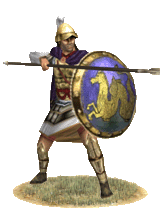 Indohellenikoi Eugeneis Hoplitai are the elite infantrymen of Hellenic India, drawn from the Indo-Greek population, be they descendants of those settled during Alexander’s invasion or recent immigrants from Baktria. They wear an evolved Boiotian helmet that offers protection against both weapons and the sun so it won’t obstruct their view. They also wear elaborately decorated bronze cuirasses with Indian motifs, pteryges, perikneimides (full greaves) and of course a heavy bronze hoplon shield to complete their armor. An iron-tipped spear is their primary weapon, but should the need arise they are also armed with an evolved kopis or Khukhri as the Indians call it, a medium sized sword of Indian steel made for slashing. In fact, when compared to the Hoplites of old, they are more mobile and have better vision of the battlefield, due to the evolved Boiotian helmet they wear. They are also equally skillful with spear or sword. These men are among the finest soldiers in India or at least in the Indus valley and western Gangetic plains and can be relied on to do their duty to a man, but a wise strategos knows to use these troops with care as there are few Hellenes in the East and their numbers are not easily replaced. In fact they, along with the Sreni (Professional guild warriors) were the ones that the Indogreek kings relied upon to hold the line. Indohellenikoi Eugeneis Hoplitai are the elite infantrymen of Hellenic India, drawn from the Indo-Greek population, be they descendants of those settled during Alexander’s invasion or recent immigrants from Baktria. They wear an evolved Boiotian helmet that offers protection against both weapons and the sun so it won’t obstruct their view. They also wear elaborately decorated bronze cuirasses with Indian motifs, pteryges, perikneimides (full greaves) and of course a heavy bronze hoplon shield to complete their armor. An iron-tipped spear is their primary weapon, but should the need arise they are also armed with an evolved kopis or Khukhri as the Indians call it, a medium sized sword of Indian steel made for slashing. In fact, when compared to the Hoplites of old, they are more mobile and have better vision of the battlefield, due to the evolved Boiotian helmet they wear. They are also equally skillful with spear or sword. These men are among the finest soldiers in India or at least in the Indus valley and western Gangetic plains and can be relied on to do their duty to a man, but a wise strategos knows to use these troops with care as there are few Hellenes in the East and their numbers are not easily replaced. In fact they, along with the Sreni (Professional guild warriors) were the ones that the Indogreek kings relied upon to hold the line.
Historically, infantrymen like these were scarce, but they still built up a fearsome reputation and Hellenes were sought after as bodyguards all over India, there is even mention of Hellenes serving as bodyguards in far away Sri Lanka. The Indo-Greek kingdoms themselves can be called Baktrian successor kingdoms as it was the Hellenes of Baktria who invaded India after the Mauryan collapse and it was Baktrian Hellenic nobles who made themselves lords in their new conquests. The Indo-Greek kingdoms were established during the civil wars and rebellions that were common in the Graeco-Baktrian Empire after 200 BC and after Baktria itself was overrun by the Saka and other nomadic groups. Evidence indicates that most infantrymen in the far eastern Hellenic kingdoms were drawn from subject peoples, except the most elite units who were made up of Hellenes and thoroughly Hellenized subjects. The same seems to have been in the case of the Indo-Greeks too, who levied large numbers of Indians to serve as infantry. Some sources indicate that Indian infantry apparently were poorly disciplined and had a low morale and thus prone to desert or rout. One battle used to illustrate this is the siege of Baktra, where 300 horsemen lead by Eukratides sallied out from the city and routed the Indo-Greek King Demetrios II’s army of 60000 men all the way to the Indus River, according to Justin (XLI,6). Apparently after this more reliable elite infantry units were raised and dispersed among the Indian infantry to try and maintain morale and lead by example.
Indohellenikoi Eugeneis Hoplitai were infantrymen who served in the Indo-Greek Kingdoms as crack troops, but units like these were likely to have fought in Baktrian armies as well, one reason being that Baktria did field elite infantry units of their own and these men would simply have been an Indo-Greek variant of those. The Saka, knew a good thing when they saw it, so not only did they keep them as a fighting force, enhancing them with their own people and fighting elements, meaning a bigger emphasis on sword than spear, a gradual shift that would take centuries to complete.
Graphical evidence includes a frieze showing a hoplite in full gear in a relief wearing the chlamys found in Butkara, National Museum of Oriental Art. There is also a Hero Stone in southern India, a dead Ksatriyas' grave, showing two rows of over hand holding spearmen, armed also with an aspis shield attacking each other, with the Hero dieing a glorious death.
Some Puranic (Indian epic) references on them... Kane quotes several minor texts in which Yavanas (Greeks) are described as barbarians (mlecchas), eaters of cow's flesh, contradictory thinkers, and having their own peculiar manner of dress and trimming of hair. (Indians at the time wore their hair long and in topknots). In other parts they are shown as different to mlecchas, above them as if leading them.
Several references to the Yavanas and their kingdom occur in Tamil epic literature and in the Ceylonese chronicle Culavamsa. In the fifth part of the Tamil epic poem Cillappatikaram, for example, the abodes of wealthy Yavanas and mercenary Yavana swordsmen are described. A Yavana kingdom existing in the North is also mentioned.
In Malinda Panha (the Buddhist monk Nagasena's account of a meeting with King Milinda or Menandros in Euthydemia, present day Sind), when the King is cornered on a difficult philosophical question, his "500 Greeks" exclaim in one voice..." Now get out of that if you can" in a most jovial mood (1st chapter). Later on they take part on the discussion as if they were expected to in some way. This indicates that they must have been pretty close to the king, the infantry part of the Basilikon Agema (King's bodyguards). In another part, he explains of a prepared military force, who is always ready for war.
The Saka used this elite force to further cement their Indian state. In time it became a mix of Yavanas, Saka and Indians, who in turn became the majority. Some Saka customs remained with them though, such as the "Ultimate Sacrifice" called "Saka" in which all those who take part, fight to the last man and either succeed or die fighting. It is not known whether a connection exists between those "Noble elites" and the Rajput-ra or "King sons'" , but the latter had that "Saka" custom as a ritual in war. Also, some of the Rajput family emblems resemble the Makedonian 16 pointed sun, which was Megas Alexandros' emblem when he started out the campaign which led to India, so many centuries before. Rajputs from the lower Indus region, in the 10th century AD fled Islamic conquest to Nepal and there they evolved into the elite Nepalese Ghurkas, who to this day carry an evolved Kopis (Khukri) and count the time by the Saka calendar.
Agema Hellenikon (Indo-Greek Royal Guard)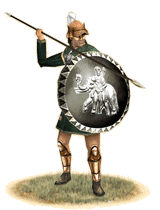 The Agema Hellenikon is a highly versatile and disciplined force of true elites, born of the less then noble final chapter of Hellenic Kingship in Baktria and India. They are the last manifestation of an Eastern branch of the ancient martial tradition of Hellas, armed with a traditional overhand spear and short sword for melee combat, and armored with iron greaves, a distinctive Boetian helmet, iron plating for their skirt, and a heavy hoplon shield; they are a truly admirable force. In the great convolution of cultural and technical interaction that took place in Gandhara, Paropamisadai, and Baktria, the original architects of their corps creatively adapted the armor and metallurgical techniques of the various violent Steppe peoples, in order to engineer a force to maintain themselves in their numerous fortified mountain keeps. Though the experiment had mixed results politically, the skill and elan of it's product was undeniable. The Agema Hellenikon is a highly versatile and disciplined force of true elites, born of the less then noble final chapter of Hellenic Kingship in Baktria and India. They are the last manifestation of an Eastern branch of the ancient martial tradition of Hellas, armed with a traditional overhand spear and short sword for melee combat, and armored with iron greaves, a distinctive Boetian helmet, iron plating for their skirt, and a heavy hoplon shield; they are a truly admirable force. In the great convolution of cultural and technical interaction that took place in Gandhara, Paropamisadai, and Baktria, the original architects of their corps creatively adapted the armor and metallurgical techniques of the various violent Steppe peoples, in order to engineer a force to maintain themselves in their numerous fortified mountain keeps. Though the experiment had mixed results politically, the skill and elan of it's product was undeniable.
Historically, the last Hellenic Kings and Princelings of Baktria and Paropamisadai, and the only slightly more stable Yavanarajyas (Indo-Greek Kingdoms) of Gandhara and Sind in order to maintain themselves, adapted a heavy infantry force based on their own ancient tradition of discipline, the Indos marshal aesthetic, and the advancing metallurgy of the Steppe. The result allowed them to briefly stave of conquest, but those that did endure, did so as the vassal kings or allied subject satraps of the Sakae. Faced with a new political environment and still harboring hopes of keeping their now much reduced domains at least for their lifetimes, they were forced to attach themselves to the cause of their new masters, which many did enthusiastically. During this new era, the old corps of Basilikon Agemata was offered up in their service (though some served their own half-Saka, half-Yavana rulers); elite warrior-jewels, beautifully clothed and armored, and deadly in the field.
Agema Hippeon Hellenikon (Indo-Hellenic Heavy Cavalry)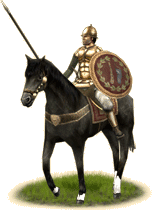 The Agema Hippeon Hellenikon is a superb cavalry force, drawn from wealthy landed Hellenes in the Satrapies around Baktria and Gandhara, provided to the Saka King of Kings by his loyal Hellenic Satraps and vassal rulers. They are armed as a heavy shock cavalry, in a mix of Hellenic and eastern equipment, protected by a heavy bronze muscle cuirass, pylos helmet, and bronze plated ptyrges, while wearing trousers (once regarded by other Hellenes as effete) & cavalry greaves. Such men are an elite force, and though they rarely use their hunting bows in combat, their value as a heavy cavalry cannot be overemphasized, particularlly when used in conjunction with other Hellenic forces or the powerful Saka cataphracts. The Agema Hippeon Hellenikon is a superb cavalry force, drawn from wealthy landed Hellenes in the Satrapies around Baktria and Gandhara, provided to the Saka King of Kings by his loyal Hellenic Satraps and vassal rulers. They are armed as a heavy shock cavalry, in a mix of Hellenic and eastern equipment, protected by a heavy bronze muscle cuirass, pylos helmet, and bronze plated ptyrges, while wearing trousers (once regarded by other Hellenes as effete) & cavalry greaves. Such men are an elite force, and though they rarely use their hunting bows in combat, their value as a heavy cavalry cannot be overemphasized, particularlly when used in conjunction with other Hellenic forces or the powerful Saka cataphracts.
Historically, some time after the Saka began assimilating the territories of Hellenic dynasts and land magnates into their own possessions, they initiated a practice of political accomodation with the old government, calling on them to raise up levies of their countrymen for service in the King of King's army. The cavalry arm of these forces, the Agema Hippeon Hellenikon, was drawn largely from the households of the wealthy rural class; Hellenes that maintained their own estates and stables, as well as relationships with their old governors. Along with the Agema Hellenikon, these units were equipped or paid for by local Hellenic satraps and vassals subject to the Saka, and prided themselves on their connection to the old traditions of Hellas, just as their commanders hoped to lead an army in the style of Megas Alexandros or the great citizen forces of their long-abandoned poleis.
Elephantes Indikoi (Indian Elephants)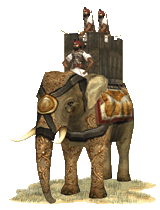 Imported from the regions around the old Eastern Persian provinces, Elephantes Indikoi are an exceptionally valuable resource in combat, very popular among Alexandros' Diadochoi. Towering over most other creatures, they can easily scare men and horses alike, with both their size and smell, though elaborate bells and trappings often add to their intimidation. Such corps are directed by their own mahouts riding behind their heads, often a native of their own country who has spent at least two years training his beast from capture. The mahout is armored to better protect against the obvious assault that generally comes against him, launched to bypass the thick natural armor of his mount. Imported from the regions around the old Eastern Persian provinces, Elephantes Indikoi are an exceptionally valuable resource in combat, very popular among Alexandros' Diadochoi. Towering over most other creatures, they can easily scare men and horses alike, with both their size and smell, though elaborate bells and trappings often add to their intimidation. Such corps are directed by their own mahouts riding behind their heads, often a native of their own country who has spent at least two years training his beast from capture. The mahout is armored to better protect against the obvious assault that generally comes against him, launched to bypass the thick natural armor of his mount.
Elephants are best used as cavalry screens for your army, where their presence can scare away enemy cavalry. They can also be used to ram through an enemy battle line, though they are less useful when faced with loose order or phalanx infantry. Pyrrhos of Epeiros even innovated a tactic of flank screens when he fought the Romans at Heraklea. Beyond their obvious use against enemy infantry or cavalry, they can also be used in siege combat; battering down gates, though they're highly vulnerable to better prepared installations. Their greatest vulnerability is against skirmishers, slingers and archers, who can pepper them with missiles - eventually toppling them by virtue of their cumulative impact. To counter the effect of enemy skirmishers, it is often wise to array your own in opposition, or to maintain constant attacks upon each individual group.
Historically, the use of elephants in war was largely contained to India, but after the battle of Hydaspes that changed. Though Alexandros never cared over much for the animals, his successors were very much in favor of their use, organizing their own elephants into a distinct corps under their own "elephantarchos". These "Elephantes Indikoi" (Indian Elephants) were imported for war in the West from the old Eastern Persian provinces around Baktria, Gandhara, Sattagydia, and Sind - though most originally hailed from the regions directly around the river the natives call the Sindhu. In the first wars of succession, each Diadochoi had a contingent of Indian elephants and Indian mahouts, who stayed on where they taught the Hellenes how to capture and train elephants for war. Such forces had been wreaking havoc on battle lines for centuries within the armies of Indian Rajas, and the Diadochoi used them on an equal scale (the first substantial group supposedly numbered 500 elephants total, granted to Seleukos I Nikator by his new ally Chandragupta Maurya, called "Sandrokottos" in Greek), attaching substantial political power to their possession - some officers gained temporary power and success simply by this virtue (most notably, the Eastern Satrap Eumenes).
Despite their great usefulness when properly employed, it was not unusual for elephants to cause defeat for those who employed them. If an enemy was clever enough to devise their own means to combat elephants, as was the case at the battle of Gaza when Ptolemaios planted an ‘iron spiked minefield’ to ward off elephants, or when Caesar properly utilized slingers and Scipio gaps between his infantry cohorts to channel the elephants, they could be defeated and even turned against their masters. Even pigs were used on occasion, released among elephants who were often scared of their comparatively small, darting forms. However, despite the many different weapons and stratagems being devised to fight them and the huge expenses required to maintain them, the elephant was still considered a valuable asset, maintained widely. The Arche Seleukeia even developed a corps of ‘elephant guards,' whose task was simply to defend the beasts in combat.
Other non-Hellenic powers also used Indian elephants in war, but it seems not to the same great extent. These powers started using elephants when they gained control of Indian provinces, such as the Pahlava, Kushan Empire and the Indo-Saka kingdoms.
Elephantes Kataphraktoi Indikoi (Armoured Indian Elephants)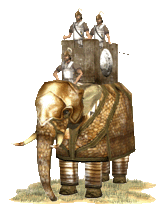 Imported from the regions around the old Eastern Persian provinces, Elephantes Kataphraktoi Indikoi are an exceptionally valuable resource in combat, very popular among Alexandros' Diadochoi. Towering over most other creatures, they can easily scare men and horses alike, with both their size and smell, though elaborate bells and trappings often add to their intimidation. Such corps are directed by their own mahouts riding behind their heads, often a native of their own country who has spent at least two years training his beast from capture. The mahout is armored to better protect against the obvious assault that generally comes against him, launched to bypass the thick natural armor of his mount. A thorakion (tower) or howdah is also attached to the elephant's back, which serves as a missile platform for a few archers. The elephant itself is also armored, protecting its head and sides and thus giving the elephants a much better chance at resisting enemy missile fire. Imported from the regions around the old Eastern Persian provinces, Elephantes Kataphraktoi Indikoi are an exceptionally valuable resource in combat, very popular among Alexandros' Diadochoi. Towering over most other creatures, they can easily scare men and horses alike, with both their size and smell, though elaborate bells and trappings often add to their intimidation. Such corps are directed by their own mahouts riding behind their heads, often a native of their own country who has spent at least two years training his beast from capture. The mahout is armored to better protect against the obvious assault that generally comes against him, launched to bypass the thick natural armor of his mount. A thorakion (tower) or howdah is also attached to the elephant's back, which serves as a missile platform for a few archers. The elephant itself is also armored, protecting its head and sides and thus giving the elephants a much better chance at resisting enemy missile fire.
Elephants are best used as cavalry screens for your army, where their presence can scare away enemy cavalry. They can also be used to ram through an enemy battle line, though they are less useful when faced with loose order or phalanx infantry. Pyrrhos of Epeiros even innovated a tactic of flank screens when he fought the Romans at Herakleia. Beyond their obvious use against enemy infantry or cavalry, they can also be used in siege combat; battering down gates, though they're highly vulnerable to better prepared installations. Their greatest vulnerability is against skirmishers, slingers and archers, who can pepper them with missiles - eventually toppling them by virtue of their cumulative impact. To counter the effect of enemy skirmishers, it is often wise to array your own in opposition, or to maintain constant attacks upon each individual group. These "towered" elephants though are much less vulnerable then their unarmored corps, well protected as they are by their own armor and skirmisher mounts of their own.
Historically, the use of elephants in war was largely contained to India, but after the battle of Hydaspes that changed. Though Alexandros never cared over much for the animals, his successors were very much in favor of their use, organizing their own elephants into a distinct corps under their own "elephantarchos". These "Elephantes Kataphraktoi Indikoi" (Armoured Indian Elephants) were imported for war in the West from the old Eastern Persian provinces around Baktria, Gandhara, Sattagydia, and Sind - though most originally hailed from the regions directly around the river the natives call the Sindhu. In the first wars of succession, each Diadochoi had a contingent of Indian elephants and Indian mahouts, who stayed on where they taught the Hellenes how to capture and train elephants for war. Such forces had been wreaking havoc on battle lines for centuries within the armies of Indian Rajas, and the Diadochoi used them on an equal scale (the first substantial group supposedly numbered 500 elephants total, granted to Seleukos I Nikator by his new ally Chandragupta Maurya, called "Sandrokottos" in Greek), attaching substantial political power to their possession - some officers gained temporary power and success simply by this virtue (most notably, the Eastern Satrap Eumenes).
However, even with many different anti-elephant weapons being used and with the huge expenses, time and effort that had to be put into maintaining an elephant herd, the elephant was still employed so it shows that it was still valued and served its purpose. The Seleukides even developed specific ‘elephant guards’ units, whose task was to solely defend these beasts. The elephant riders or the mahouts, were often called Indoi, as in the beginning they were all Indians and the majority of mahouts continued to be Indians, yet they did teach their skills to ‘westerners’ as well, as the Ptolemaioi did not have access to India yet they kept a sizeable elephant corps. The mahouts often wore protective armor as they were an obvious target for enemy missiles, even though ancient artists often portray them unarmored, which is highly likely to have been how they dressed for parades.
Other non-Hellenic powers also used Indian elephants in war, but it seems not to the same great extent. These powers started using elephants when they gained control of Indian provinces, such as the Pahlava, Kushan Empire and the Indo-Saka kingdoms.
Hindus Pattisainya (Indian Spearmen)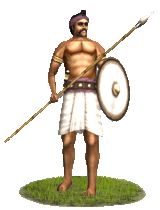 All across the lands of the East the tribes of the Hindus have spread themselves, teaming across a region larger even then the empire of the conqueror Alexandros himself. Despite their far-flung habitation, the practice of war was much the same among most of them. These Hindus Pattisainya are a fine brigade of lightly armed spearmen drawn from a number of tribes like the Gandharas and those that the Hellenes called the Aspasios, or even the Yaudheya beyond the Hindus itself. Their tribal differences occassionally spring up, but by and large they are united by their common religion - mostly some form of Buddhism, but often enough they can find accomodations with their own local or shared gods. Though armed only with a light shield and a bamboo spear, they are well suited to combat in a number of regions, and are incredibly useful auxiliaries. All across the lands of the East the tribes of the Hindus have spread themselves, teaming across a region larger even then the empire of the conqueror Alexandros himself. Despite their far-flung habitation, the practice of war was much the same among most of them. These Hindus Pattisainya are a fine brigade of lightly armed spearmen drawn from a number of tribes like the Gandharas and those that the Hellenes called the Aspasios, or even the Yaudheya beyond the Hindus itself. Their tribal differences occassionally spring up, but by and large they are united by their common religion - mostly some form of Buddhism, but often enough they can find accomodations with their own local or shared gods. Though armed only with a light shield and a bamboo spear, they are well suited to combat in a number of regions, and are incredibly useful auxiliaries.
Historically, the infantry employed by Hindus kings like Ambhi, the two Purushotthama kings of Kekeya (the two Paurava kings), or even the far off dynasts of the Audumbaras and Yaudheyas, was dominated by light armed levies like these. Particularly among the former peoples in Gandhara and farther North among the Southern Kambojas, where class restrictions on warfare were more relaxed, and peasant levies more prevelant. They fought valiantly for their kings when men like Megas Alexandros brought his campaign to the banks of the Hindus, and even more so in their own ancient epics of battle and spiritual awakening. Later on, they fought for Alexandros himself in contingents provided by his vassals, and at various times in the armies of Indo-Greek kings like Menandros and Antialkidas. In these later times, they were a huge and formidable component of Indo-Hellenic armies, but had more restricted or varied origins. Under Menandros, they were probably heavily drawn from the Madras, Sibis, Kekeyas, and other Gandhara peoples - though local levies from among the Yaudheyas, Audumbaras, and other Buddhist peoples of his massive empire - while the armies of Zoilos or Lysias probably included more peoples of the West-Central Hindus region. Later, under the Saka, they probably served mostly as light garrison or support troops for their countrymen in the archer corps or the King's Hellenic infantry.
Hindus Patiyodha (Indian Longbowmen)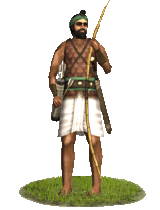 The Hindus tribes west of the Indus are famed for their use of massive longbows made from cane and strung with tough silken bowstrings. These bows allow them to launch arrows at a tremendous range, making their users essentially immune to enemy horse archers and projectiles. They wear no armor and rely simply on their skills with the large Indian sword to get them out of less certain melee encounters. These Indians can be the lynchpin of a proper 'wearing down' before a dedicated melee engagement, thinning the ranks that the more dedicated melee fighters will encounter. The Hindus tribes west of the Indus are famed for their use of massive longbows made from cane and strung with tough silken bowstrings. These bows allow them to launch arrows at a tremendous range, making their users essentially immune to enemy horse archers and projectiles. They wear no armor and rely simply on their skills with the large Indian sword to get them out of less certain melee encounters. These Indians can be the lynchpin of a proper 'wearing down' before a dedicated melee engagement, thinning the ranks that the more dedicated melee fighters will encounter.
Historically, the longbowmen of India were a famous and fearsome force, utilized by every effective army ever mobilized in the region - even Alexander the Great took advantage of their easy availability, receiving a number of them in the levy contingents from his newly acquired vassal kings. A century later, as the Baktrian Kings became more settled and grew into the roles of a "Raja," as opposed to a traditional Hellenic Basileos, such archers became a more regular component of their native levy - probably freeing most Hellenes from the lower orders of the psiloi, in order to concentrate them in their "national" phalanx. Even the archery-oriented Saka used them to augment their own foot archers, or to support their cavalry divisions, expanded as more and more cultivated land came under their power. Forunately for the Baktrians, Saka, and even the occassional non-regional power to invade India, longbowmen are a regular feature of the local military infrastructure, and easily accessable to anyone.
Sreni Pattya Yoddaha (Infantry Guild Warriors)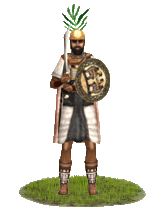 Self regulating professional guilds, called ‘Sreni’ formed an important part of the social fabric of the Indian sub-continent in the 3rd century B.C. Some of these were guilds of war-craft, and their members dedicated their lifetime to the art of war, conducting their affairs according to a strict code of ethics. Self regulating professional guilds, called ‘Sreni’ formed an important part of the social fabric of the Indian sub-continent in the 3rd century B.C. Some of these were guilds of war-craft, and their members dedicated their lifetime to the art of war, conducting their affairs according to a strict code of ethics.
These infantry are equipped with the best that money can buy. For defense, they wear armour of iron and brass scales over a quilted cotton cuirass, with additional protection for the arms, legs and shoulders. For offense, they carry a large ‘sword-axe’ made of high quality iron from the mines of Magadha. At this point in history, the metal-craft of Magadha was well in advance of anything in the Mediterranean and so the equipment was of very high quality.
Heavily armoured, steeped in a warrior tradition and bound by a professional code of warrior ethics, these troops can be relied on to hold the battle line in the most trying of circumstances.
Historically, most of what we know of ancient Indian armies comes from Kautilya’s ‘Arthashastra’ (a manual on statecraft) and sparse depictions in Buddhist art (notably at Barhut and Ajanta). Kautilya makes it clear that troops from the ‘Sreni’ formed an integral part of the royal army and were trusted second only to the king’s own standing army. Scattered references from our sources also indicate that professional mercenary companies from India were in regular employment, fighting for and against the Achaemenids, and later for and against Alexander and his successors.
Kamboja Asvaka Ksatriya (Indo-Iranian Light Cavalry)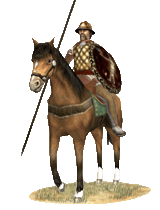 Master horsemen and horse traders, Kambojas never leave an opportunity to plunder using their light horse troops. Living on both sides of the Khyber Pass, they were a part of the "Arya" races which stormed and conquered India, some 1500 years before. Their own name was a mistaken identity by the Helllenes of Alexandros who called them "Assakenoi" whereas they were "Asvaka" or "horsemen" in Sanskrit. Losing badly to Alexander, they befriended his descendants, their Greco-Baktrian overlords and along with them they invaded India reaching as far as present day Bangladesh. They repeated this feat, but with their new Lords, the Sakae who overran Greek Baktria in the end of 1st centrury BCE. Their helmet is an evolved Boiotian one, and their primary cuirass is a quilted silk one. Untreated (so called "dirty") silk had very good anti-missile qualities, which Kambojas facing Indian foot archers and Steppen Horse archers would deffinitely appreciate. They wear Iranian dotted pantaloons and have pteryges to cover their genitals. Their weapons are clearly Hellenic: round "Aspis" shield, a short kontos spear that could be held underarm in a stance reminding that of the knights, and a sturdy kopis for the time when the spear gave way. It is safe to assume that they would show the same faith to all their overlords, whoever they might be. Master horsemen and horse traders, Kambojas never leave an opportunity to plunder using their light horse troops. Living on both sides of the Khyber Pass, they were a part of the "Arya" races which stormed and conquered India, some 1500 years before. Their own name was a mistaken identity by the Helllenes of Alexandros who called them "Assakenoi" whereas they were "Asvaka" or "horsemen" in Sanskrit. Losing badly to Alexander, they befriended his descendants, their Greco-Baktrian overlords and along with them they invaded India reaching as far as present day Bangladesh. They repeated this feat, but with their new Lords, the Sakae who overran Greek Baktria in the end of 1st centrury BCE. Their helmet is an evolved Boiotian one, and their primary cuirass is a quilted silk one. Untreated (so called "dirty") silk had very good anti-missile qualities, which Kambojas facing Indian foot archers and Steppen Horse archers would deffinitely appreciate. They wear Iranian dotted pantaloons and have pteryges to cover their genitals. Their weapons are clearly Hellenic: round "Aspis" shield, a short kontos spear that could be held underarm in a stance reminding that of the knights, and a sturdy kopis for the time when the spear gave way. It is safe to assume that they would show the same faith to all their overlords, whoever they might be.
Historically, Kamboja, were among the westernmost of the 16 or so nations (mahajanapadas) which comprised the Archaic (Vedic) Indian world. IndoIranians to the utmost, they presumably took the name from river Kabul (then named Kaboj) or from Kam(region)-used mostly in those areas to this date- and Bhoja(owner). They must have a major impact on the Achaimenid Persians who conquered them, as Cyrus the great (Kurush) named his son Kambyses (Kambujiya) the 3rd, presumably after a Mythical hero, Kambujiya (Kamboja of Shantiparava),who led the Iranians against a Vedic king Kuvalashava, defeating him in the battle and wresting a prized sword from his lineage. Thus, it can be easily understood that common language and mythical bonds made Achaimenids and Kambojas friendly to one another.
This good relation with their overlords would change later, as the Kamboja clans—the Aspasioi of Kunar/Alishang valleys, the Guraeans of the Guraeus (Panjkora) valley and the Assakenoi of the Swat and Buner valleys fought the Makedones to a man. When worse came to worst, even the Assakenoi(Ashvakayanas) Kamboj women had taken up arms and fought the invaders side by side with their husbands, thus preferring "a glorious death to a life of dishonor". In fact Alexander spent a couple of years at present day Afghanistan and NW Pakistan fighting Kamboja clans. These highlanders, designated as "parvatiya Ayudhajivinah" in Panini's Astadhyayi were rebellious, fiercely independent and freedom-loving clans who never easily yielded to any overlord. Modern historians have this to say on them ...."It was indeed a hard work for Alexander to take their strongholds, of which Massaga and Aornus need special mention (A. K. Narain, 'Alexander the Great') and "A tribute must be made to the vision and sagacity of Alexander because he realised that without reducing these highlanders, his march into India would neither be secure nor effective."(History of Punjab, Vol I, 1997, p 225, Dr Buddha Prakash). This was the wonder and the tragedy of those people. That they controled the way to India, thus they had to be either conquered or destroyed.
Survivors were a lot less willing to fight off superior forces than their ancestors. Instead they played along with the plans of their overlords and managed to survive and prosper. They must have been hellenized to a degree, as is evident by the following excrept of Assalaya Sutta of Majjhima Nikaya, the second book of the Sutta Pitaka (written probably around the end of first century BCE or 2nd centruy AD)- Buddha says:"Have you heard that in the countries of Yona(yonaratthan) [greek territory] and Kamboja (kambojaratthan) and other adjacent districts there are only two castes, master and slave? And having been a master one becomes a slave? Having been a slave, one becomes a Master? - Yes, I have heard this, Sir, in Yona and Kamboja...having been a slave, one becomes a master." If we compare this to the Asoka's 13th edict where the country of the Yonas is mentioned as the only place where the caste system doesn't exist. Of course it was written more than 100 years earlier than that Buddhist script. Kambojas took part willingly in the Baktrian invasion of India which must have led to the creation of the separate Indo-Greek state by 186 BCE (time when the Indo-Greek calendar begins) and as a spoil of war, they were allowed to settle along their Indo-Greek Overlords in India, both all along the Indus river and in the center of India Mathura and eastern on.
Indians wrote the following, according to Majjhima Nikaya 43.1.3. ; Ganapatha II.1.72; Harivamsa 14.16. "Both people are attested to follow common culture, social customs and manners like supporting short cropped hair, non-entertainment of Brahmanas in their countries and observing two varna=caste/class (Arya and Dasa=master and slave) social system instead of chatur-varna observed by the Indo-Aryans ". Greco-Baktrians managed to control western and Central India in a few decades. That wouldn't have been possible without the help of Buddhist local population (who were persecuted by the Hindu majority), and their vassals, Bahlikas (Baktrioi Hippeis) and Kamboja Asvaka Ksatriyas, excellent horsemen, to compliment their own cavalry, chosen Phallanxes, Hypaspistai and Agemata.
Manusmriti (X/43-44) lists the Yavanas with the Kambojas, Sakas, Pahlavas, Paradas etc and regards them as degraded Kshatriyas (members of the warrior caste). Hence the "Ksatriya" in its name.
The "Yonakambojesu" expression (Yonas and Kambojas alike) in Ashoka's Thirteen Rock Edict as well as in the Majjhima Nikaya powerfully attest very close relations of the Kambojas with the Yavanas. Mahabharata contains references to Yavanas and Kambojas having conquered Mathura. Kambojas had also entered India and spread into whole of North India, especially in (present day) Punjab and Uttar Pradesh. According to Agni Purana (A hindu holy text), it locates two Kamboja settlements in India itself. Kambhoja in south-west India and Kamboja in southern parts of India, even if it can be debated that this account was much later than our timeline.
When the Saka-Rauka conquered the Baktrian state, and were preparing to move into India to fight the Indo-Greeks. Along with 4 other tribes (Bahlikas, Parama Kambojas, Rishikas, Paradas) they were among the armies of the Saka-Rauka who invaded and occupied India.
Illustrious traders that they were, they reached even unto Taprobane, present day Sri Lanka. Cave inscriptions found in Anuradhapura which strongly attest the existence of one Kamboja Sangha (Goshatha) and Grand Kamboja Guilds in ancient Sinhala. These inscriptions are believed to belong to second century BCE (Dr S. Paranavitana). Later on, centuries later a Kamboja trader is said to have reached into a country in Indochina, whose reign he acquired, giving it the name of his people. Presently it is known as Cambodia.
Throughout the Indian literature, the Kambojas are honoured for their h.rses. All major Indian religions have a lot to say about them. Jain Canon Uttaradhyana-Sutra informs us that a trained Kamboja horse exceeded all other horses in speed and no noise could ever frighten it. The epics, Puranas and numerous other ancient Sanskrit texts all agree that the horses of the Kamboja, Bahlika and Sindhu regions were the finest breed.
Sauptikaparva of Mahabharata ranks the horses from Kamboja as of the finest breed. Bhishamaparva of Mahabharata refers to the quality war horses from various lands and puts the steeds from the Kamboja at the head of the list specifically styling them as the leaders (Mukhyanam) among the best breed of horses.
Taxilan Agema (Indo-Iranian Heavy cavalry)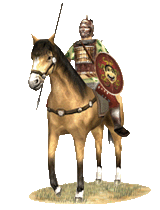 Heavy cavalry, exclusive to the Gandhara region, those mostly Indo-Iranian horsemen combine elements of both Hellenic weapon and armor mastery, and Indian excellent iron forging traditions. Wearing a Hellenic facemask made to resemble the syncretic deity of Zeus-Ahura Mazda with his distinct outflowing sunrays, armed with a small "cavalry" aspis shield, a spear and a kopis for close work and a leather cuirass, those alone would classify him a heavy cavalry. Yet, worn above the leather cuirass is the true Mauryan ion forging skills evident. Right on the edge of the facemask begin a circular leather shoulder and neck protector, with iron and bronze scales intertwined. His cloak, heavy at the shoulders for enhanced slash protection is basically two parts, that are tied together prior to battle. On top of his leather cuirass, a wooden frame is held together by leather straps. Therein either metal shards or rectangular lamellae are held together by the wooden frame, making a very Indian style "framed breastplate", on top of his hardened leather cuirass. An Iranian style pantaloon and perikneimeides' also known as greaves complete the picture. Heavy cavalry, exclusive to the Gandhara region, those mostly Indo-Iranian horsemen combine elements of both Hellenic weapon and armor mastery, and Indian excellent iron forging traditions. Wearing a Hellenic facemask made to resemble the syncretic deity of Zeus-Ahura Mazda with his distinct outflowing sunrays, armed with a small "cavalry" aspis shield, a spear and a kopis for close work and a leather cuirass, those alone would classify him a heavy cavalry. Yet, worn above the leather cuirass is the true Mauryan ion forging skills evident. Right on the edge of the facemask begin a circular leather shoulder and neck protector, with iron and bronze scales intertwined. His cloak, heavy at the shoulders for enhanced slash protection is basically two parts, that are tied together prior to battle. On top of his leather cuirass, a wooden frame is held together by leather straps. Therein either metal shards or rectangular lamellae are held together by the wooden frame, making a very Indian style "framed breastplate", on top of his hardened leather cuirass. An Iranian style pantaloon and perikneimeides' also known as greaves complete the picture.
Historically, closely after Alexandros died, his Indian pocessions became the property of one of the greatest Indian dynasties to come out of the Magadha area, the Mauryans, named after its founder Chandragupta Maurya. Be it his immitating of the tolerant Seleukid ways, be it that he felt gratitude toward the "Yavanas/Yonakas" mercenaries who helped him assume the throne, Chandragupta Maurya, allowed free reign on all. This is further demonstrated by his grandson Asoka Maurya, in his Bilingual (Greek and Aramaic) inscriptions at Kandahar/Gandahara (Shar-i-kuna). (3rd century BCE). They were preserved at the Kabul Museum.
Today they have disappeared. There he had written among other verses which proclaimed abstaining from killing..."and obedient to their father and mother and to the elders, in opposition to the past also in the future, by so acting on every occasion, they will live better and more happily". It has been suggested that Ashoka has had a quarter Greek blood, as his grandfather Chandragupta did marry Seleukos' daughter, but that is beside the point. It may be that his supposed quarter Greek ancestry did make him more hospitable towards Yavanas and other Northwestern "barbarians", but it is more prudent to assume that Ashoka had studied government, and had learned about Seleukos forging a kingdom out of nothing through "tolerance" and "synthesis" of foreign elements. This process would come to be known thousands of years later in a land far far away as "E pluribus unum".
It is rare that a fusion of cultures, ideas, religions and yes, warrior cultures happens. It is however very fortunate that in the cases that it does, units that combine all the great aspects of their perspective "schools of thought" so far as military technology of the time. The Greek facemask, maybe the best form of facial protection at the time would start a legacy that would last for at least 1500 years across all Asia. The small round shield, by no means a Greek invention, is still in use in India, in Kalaripayattu martial arts discipline. Kopis sword, is now known as Khukri and the resemblance to the Kopis is uncanny. The cuirass has certainly evolved away from what the Taxilan Agema wear. A heavy Nissean or Kambojan horse is what the Taxilan agema is mounted on, and even if it isn't armored, nobody can say the same for his rider. Taxilan agema will fight for whomever owns the regions that they are recruited in, and do so until they die, or their horses collapse from under them.
|
 |
|
 |






















|